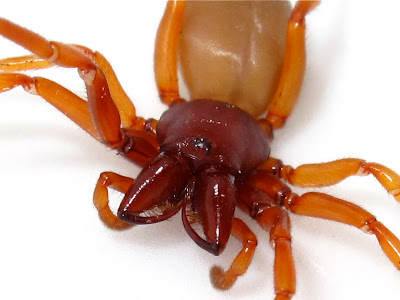I was out and about this weekend taking advantage of our "mini-spring". When repotting some self-seeded daisies I came across a few millipedes in the soil. I seem to always encounter the same species (maybe the same genus I should say, as there are several similar looking species) of millipede: a long, thin type of various sizes, which, upon encounter rolls itself into a spiral. This is the aptly named millipede
Cylindroiulus. The commonest UK species is
C. punctatus and it is likely this is my garden's species. Millipedes (Class Diplopoda) like insects and spiders are arthropods, and they are thought been amongst the first animals colonising land, some time in the Silurian Period, over 400 million years ago. There are around 10,000 described species, although there are probably several times that number of species to be described. Just 52 of them are known from the U.K. Millipedes are mainly detritus-feeders, and are often found in the soil, leaf litter, or on dead wood, where they contribute to the recycling of vegetal matter.
Millipedes means "A thousand legs" but millipedes, although having more legs than centipedes, don't have a thousand legs, the record holder is, apparently, 750! Each of the millipedes body section has two pair of legs, except the few rings behind the head. Their antenna are elbowed and clubbed, and they constantly tap the ground while they move.
Cilindroiulus has eyes, but many millipedes, especially those permanently living in the soil or in caves, lack eyes. A curious feature of millipedes eyes is that they add ocelli as they moult, so that adults have much large eyes, and likely much better eyesight, than juveniles. The ocelli are added so precisely to each moult than the growth stage can be determined in some species by counting the rows of ocelli.

Millipedes can deter predators, physically, curling up into a spiral which shelters the head and ventral area (above), exposing only the chitinous, hard dorsal rings, in a similar way to an armadillo or pill woodlouse. At the same time they curl up, they display their chemical defence: they secrete cocktails of repellent and/or toxic chemicals through glands present in each body ring when attacked. In large centipedes the smell may be quite obvious, in small ones, you have to sniff them to detect the smell. Some small predators might be killed by these chemicals if confined with the millipede in a small space, or deterred by the smell. Despite this defence, millipedes fall prey to birds who like to explore the leaf litter, such as blackbirds.
During winter, Cylindroiulus moves down into the soil, and sometimes several individuals roll up together during winter or hide under bark. That is what the usually wood dwelling millipede was doing under the pot soil.
More information
Stephen P. Hopkin, Helen J. Read. 1992. The biology of millipedes. Oxford University Press, 1992 233 pp.
Gordon Blower. 1985. Millipedes: keys and notes for the identification of the species. Brill Archive. 242 pages.







































